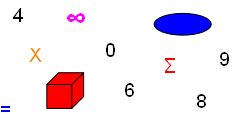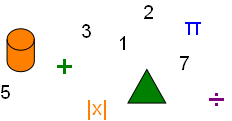



The Determinant of a Square Matrix


Determinants develop from number patterns that emerge when solving systems of linear equations. Every square matrix can be associated with a negative, positive or zero real number determinant. The use of a determinant is algorithmic rather than mathematical and is important to solve for variable quantities of linear equation systems by Cramer’s Rule.
Minors and Cofactors of a Square Matrix:
The reason for introducing minors and cofactors of a square matrix is to develop a constructive foundation necessary to create a matrix determinant.
The minor, Mij, of the entry aij is the determinant of the matrix. It is obtained by deleting the j th row and the i th column of A.
The cofactor Cij of entry aij is:
Cij = (−1) i + j Mij
Cofactors have a sign pattern:
Matrix Cofactor Sign Pattern
4×4 | C1 | C2 | C3 | C4 |
R1: | + | − | + | − |
R2: | − | + | − | + |
R3: | + | − | + | − |
R4: | − | + | − | + |
The sign pattern begins as a “+” top left and then alternates as “−/+” thereafter for each element of the row. The next row beneath the first begins with a “−”, and then alternates “+/−”. The alternating pattern continues for the entire matrix.
Finding the Minors and Cofactors of a Matrix
To find the minors and cofactors (we’ll visually present the first two minors so you can easily understand the process):
The first minor M11 …
Matrix A
3×3 | Column 1 | Column 2 | Column 3 |
Row 1: | 0+ | 2− | 1+ |
Row 2: | 3− | −1+ | 2− |
Row 3: | 4+ | 0− | 1+ |
M11
−1 | 2 |
0 | 1 |
=
−1(1) − 0(2) = −1
(Diagonal multiplication and then product subtraction)
The second minor M12 …
Matrix A
3×3 | Column 1 | Column 2 | Column 3 |
Row 1: | 0+ | 2− | 1+ |
Row 2: | 3− | −1+ | 2− |
Row 3: | 4+ | 0− | 1+ |
M12
3 | 2 |
4 | 1 |
=
3(1) − 4(2) = −5
The remaining minors are determined using the same rule-based process …
M11 = −1
M21 = 2
M31 = 5
M12 = −5
M22 = −4
M32 = −3
M13 = 4
M23 = −8
M33 = −6
Then, to find the cofactors, apply the matrix cofactor sign pattern to the minors …
C11 = −1
C21 = −2
C31 = 5
C12 = 5
C22 = −4
C32 = 3
C13 = 4
C23 = 8
C33 = −6
Expanding by Cofactors to Find the Matrix Determinant
For any matrix of order 2×2 or greater the determinant is the sum of the elements in any row or column multiplied by their respective cofactors:
det(A) = a11C11 + a12C12 + . . . + a1nC1n
By this definition, to find the determinant of A:
Matrix A
3×3 | Column 1 | Column 2 | Column 3 |
Row 1: | 0+ | 2− | 1+ |
Row 2: | 3− | −1+ | 2− |
Row 3: | 4+ | 0− | 1+ |
We can choose row 1 with array elements 0, 2, 1, multiply each element by its cofactor and then sum the products of the multiplication (a row or column with the most zeros):
det(A) = 0(−1) + 2(5) + 1(4) = 14
Or, we could choose column 2 with array elements 2, 1, 0:
det(A) = 2(5) + −1(−4) + 0(3) = 14
The determinant of matrix A is 14.
Now you see the role minors and cofactors play in determining a matrix determinant and how to produce the determinant. However, because it is important to understand how to find a determinant the following information provides matrices of order 1×1 and 2×2, each with a detailed description of the process for finding their determinant.
Determinant of a 1×1 Matrix:
The determinant of a matrix with order 1×1 is the entry of the matrix, the array element value: Matrix A = [−5] then det(A) = −5
Determinant of a 2×2 Matrix:
The determinant of a 2×2 matrix is produced by subtracting after diagonal multiplication of array elements. It is the matrix formula and only works for a 2×2 matrix.
Matrix A
a1 | b1 |
a2 | b2 |
det(A) = a1b2 − a2b1
Matrix B
0 | ½ |
2 | 4 |
det(B) = 0 − 1 = −1
How to find the determinant of a 3×3 or 4×4 matrix can be found by clicking on tabs near the top of this page.
Copyright © DigitMath.com
All Rights Reserved.